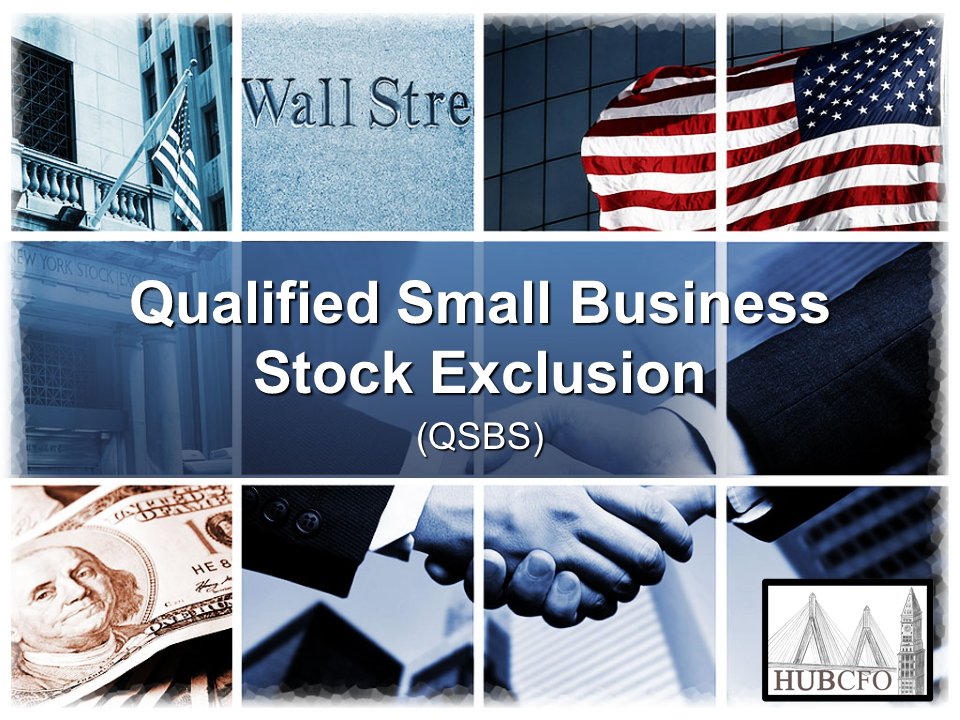Section 1202: Small Business Stock Gain Exclusion

What is Section 1202 Stock?
In December 2015, the Protecting Americans from Tax Hikes Act of 2015 (“PATH Act”) was passed by Congress and signed into law by President Barack Obama. The PATH Act made several tax breaks permanent, including the Small Business Stock Gains Exclusion (Section 1202). The new law makes permanent the exclusion of 100 percent of the gain on the sale or exchange of qualified small business stock (QSBS) acquired after September 27, 2010 and held for more than five years. the PATH Act also permanently extends the rule that eliminates the 100 percent excluded QSBS gain as a preference item for Alternative Minimum Tax (AMT) purposes. In addition, QSBS gain excluded from income is not subject to 3.8 percent Obamacare tax on “Net Investment Income” from capital gains (and other investment income) on high-income taxpayers.
This article below provides additional details on Section 1202. For questions about the PATH Act and the permanently extended or otherwise enhanced tax breaks you may qualify for, please contact us.
To encourage investment in new ventures, small businesses, and specialized small business investment companies, Section 1202 of The Internal Revenue Code grants relief to investors who risk their funds in these businesses.
Depending on the acquisition date of qualified small business stock (“QSBS”), non-corporate investors may exclude 50/75/100 percent of gain they realize on the disposition of QSBS issued after August 10, 1993, and held more than five years.
Section 1202 Stock Capital Gain Exclusion
Acquired 8/11/1993 – 2/17/2009 50%
Acquired 2/18/2009 – 9/27/2010 75%
Acquired after 9/27/2010 100%
As part of the American Recovery and Reinvestment Tax Act of 2009, the Section 1202 exclusion was raised from 50 percent to 75 percent for QSBS acquired after February 17, 2009, and before September 28, 2010. In September 2010, the Small Business Jobs Act of 2010 was enacted, amending Section 1202 to exclude 100 percent of gain from disposition of QSBS acquired after September 27, 2010, and before January 1, 2011. The Tax Relief Act of 2010, American Taxpayer Relief Act of 2012 and Tax Increase Prevention Act of 2014 further extended this 100 percent exclusion to QSBS acquired in 2011, 2012, 2013 and 2014.
The passing of the PATH Act in December 2015 permanently excludes 100 percent of the gain on the sale or exchange of QSBS acquired after September 27, 2010, and held for more than five years.
So, for QSBS purchased after September 27, 2010, a ZERO percent effective income tax rate applies to at least the first $10 million of gain upon its ultimate sale if applicable requirements are met. Excluded gain from these investments will not be treated as a preference item for AMT purposes, so the benefits extend equally to AMT taxpayers.
The amount of gain eligible for the exclusion is subject to per-issuer limits. The exclusion is available to taxpayers who own eligible stock in a qualified corporation (hold the stock for more than five years), and the corporation meets requirements that it actively conducts a qualified trade or business and is under a maximum gross assets test.
The five year holding period requirement can be satisfied no earlier than August 12, 1998, since the exclusion can only apply to stock issued after August 10, 1993.
For gain on its stock to qualify for the exclusion, a corporation must be a C corporation other than a:
• Disc;
• A regulated investment company;
• A real estate investment trust;
• A real estate mortgage investment conduit;
• A financial asset securitization investment trust;
• A cooperative; or
• A corporation electing the Puerto Rico and possessions tax credit.
Stock issued to a taxpayer cannot qualify for the exclusion if the issuing corporation purchases (directly or indirectly) any of its own stock from the taxpayer or persons related to the taxpayer, with the four-year period beginning two years before the issue date. A ‘safe-harbor’ de minimis amount can be redeemed without rendering the stock ineligible for the exclusion. The aggregate amount paid for the stock by the issuing corporation in such redemptions cannot exceed $10,000 or more than 2 percent of the stock held by the taxpayer and all related persons.
Stock will also not qualify for the exclusion if the issuing corporation engages in a ‘significant redemption’. A redemption is significant if the corporation, within a two year period beginning one year before the issuance of the stock, redeems stock with an aggregate value exceeding 5 percent of the aggregate value of all the corporation stock. A de minimis exception applies if either the aggregate amount paid for all stock redeemed during the two year period does not exceed $10,000 or no more than 2 percent of all outstanding stock.
Per-issuer limitation
There is a cumulative limit on the gain from a single issuer that a taxpayer may exclude. Eligible gain from any one corporate issuer in any given tax year is taken into account only to the extent that it does not exceed the greater of,
1. $10 million reduced by the aggregate amount of eligible gain taken into account by the taxpayer in prior years from the same issuer, or
2. 10 times the adjusted basis of all qualified stock of the issuer that the taxpayer disposed of during the tax year. Additions to the basis are disregarded. This limitation can severely restrict the tax benefit of this provision in the event of a truly substantial windfall.
The $10 million limitation is applied on a shareholder-by-shareholder basis and any property contributed to the issuing corporation is its fair market value as of the contribution date.
Married taxpayers filing separately have $5 million of eligible gain for each spouse.
Original issue requirement (Section 1202(c))
Small business stock must be acquired after August 10, 1993 by a taxpayer other than a corporation, at its original issue (directly or through an underwriter), for money, for property other than stock, or as compensation for services other than underwriting. Please note that the exclusion is not limited to a corporation’s initial stock offering, but also applies to any subsequent issuance of stock.
Gain on qualified stock held by a partnership, S corporation, RIC, or common trust is excludable if the entity held it for more than five years and the person to whom the gain passes held an interest in the entity when the entity acquired the stock.
If qualified small business stock is transferred for other stock in a Section 351 incorporation or 368 reorganization transaction, the transferor treats the stock received as qualified small business stock. The holding period of the exchanged stock is tacked to that of the stock received.
If qualified small business stock is transferred by gift, at death, or from a partnership to a partner, the transferee is treated as having acquired the stock in the same manner as the transferor, and as having held the stock during the continuous period.
Qualified Small Business Requirement (Section 1202(d))
For substantially all of the taxpayer’s holding period, the corporation must use at least 80% by value of its assets in the active conduct of a qualified trade or business. This includes assets used in furtherance of a prospective active business (Section 195 and 174 activities). It also includes working capital, investments expected to finance research, and computer software rights that produce active business royalties. However, after the corporation has existed two years, no more than 50 % of the assets can be working capital or investments held for future research.
The active business requirement is waived for specialized small business investment companies (SSBIC). An SSBIC is any corporation licensed by the SBA under Section 301(d) of the Small Business Investment Act.
A qualified trade or business does not include professional service organizations (law, accounting, architecture, etc.), banking, fanning, mining, or hotel and restaurant management. If an issuing corporation owns more than 50 percent of another corporation, its pro rata share of assets and activities is attributed to it.
A corporation is not a qualified trade or business for any period during which more than 10 percent of its assets total value consists of real estate not used in the active conduct of a qualified trade or business. Owning, dealing in, or renting real property does not qualify.
Gross Assets Test
Both before and immediately after the issue date, a qualified small business corporation’s aggregate gross assets cannot exceed $50 million. All members of a parent-subsidiary controlled group are treated as one taxpayer (>50 percent common ownership). Any contributed property is determined as if the basis were equal to the fair market value at the contribution.
Subsequently exceeding the $50 million limit does not disqualify otherwise qualifying stock, but the corporation can never again issue qualified stock.
Recomputation of certain income and deductions based on AGI
In determining whether a net operating loss carryover remains after a net operating loss is carried to another year, the amount excluded on the sale of qualified small business stock in the year the loss is carried to must be added back to taxable income.
The $25,000 exception for passive rental activities phase out with respect to AGI is determined without regard to the small business stock exclusion.
Gain excludable under this provision is not used in computing the taxpayer’s long-term capital gains or losses, and is not investment income for investment interest limitations. If a sale of stock qualifies for the exclusion, the non-excluded gain is not eligible for the 15 or 20 percent long-term capital gain tax rate. Such gain is treated as “midterm” taxable at 28 percent. If gain does not qualify for the exclusion, the entire gain may be taxed at 15 or 20 percent (the 20 percent capital gain tax rate applies to the extent a taxpayer’s income exceeds the thresholds above for the 39.6 percent ordinary income tax rate).
California Taxation With the bill AB 1412 being enacted in 2013, California does not allow any QSBS gain exclusion for stock sales made on or after January 1, 2013.
For the QSBS purchased after September 27, 2010, the 100% excluded QSBS gain is excepted from treatment as an AMT preference. In contrast, for the QSBS purchased before September 28, 2010 and disposed after May 5, 2003, , 7 percent of any gain excluded under Section 1202 is treated as a preference item for AMT purposes.
QSBS Treatment for General Partner
The benefits of Sec. 1202 are passed through to the noncorporate partners of a partnership that recognizes gain on the sale of QSBS, allowing those partners to exclude 50/75/100 percent of their share of the partnership’s gain, if:
• The QSBS qualifies as QSBS in the hands of the partnership;
• The partnership satisfies the five-year holding period described above; and
• The noncorporate partner held its interest in the partnership on the date on which such pass-thru entity acquired such stock and at all times thereafter until the disposition of such stock.
For this purpose, the amount of gain eligible for Sec. 1202 treatment at the partner level cannot exceed the amount of gain that would be allocated to the partner based on the partner’s percentage interest in the partnership at the time the partnership acquired the QSBS. The statutory language is ambiguous in the case of a fund that provides its manager with a carried interest allocation that does not become effective until a specified benchmark has been satisfied. The law does not provide a clear definition for “interest” or whether it applies to a carried interest before or after the benchmark was satisfied at the time the fund acquired the QSBS investment.
California Taxation With the bill AB 1412 being enacted in 2013, California does not allow any QSBS gain exclusion for stock sales made on or after January 1, 2013.
For QSBS sales made before January 1, 2013, California allows exclusion of 50 percent of gain from disposition of QSBS, almost identical to the federal exclusion prior to the federal amendment by the American Recovery and Reinvestment Tax Act of 2009 and the Small Business Jobs Act of 2010 (California does not conform to the 75 percent and 100 percent federal exclusions), but requires:
• At least 80 percent of the corporation’s payroll be attributable employment located within California during substantially all of the holding period and
• At least 80 percent of the corporation’s assets be used in the active conduct of qualified trade or business within California during substantially all of the holding period.
The bill AB 1412 eliminates the two-part test above after it was held unconstitutional but retains the requirement that at least 80 percent of the corporation’s payroll be attributable employment located within California at the time of stock issuance to qualify for the 50 percent gain exclusion for QSBS sales made in taxable years beginning after December 31, 2007, and before January 1, 2013.
California also does not conform to the AMT tax preference applied for federal tax purpose. It picks up one-half of the gain exclusion (i.e. 25 percent of total gain from disposition of QSBS) as a tax preference item.
Contact GROCO
At GROCO, we can assist you with these changes and other tax-related questions and concerns. Give us a call at 1-877-CPA-2006 or contact us online to find out how we can help.
Are you a Corporate, Estate and Trust, Individual, Limited Liability Company, Not for Profit, Partnership, and S Corporation income tax areas &
Looking for WEALTH & TAX PLANNING & PREPARATION SERVICES?
We hope you found this article about “Section 1202: Small Business Stock Gain Exclusion” helpful. If you have questions or need expert tax or family office advice that’s refreshingly objective (we never sell investments), please contact us or visit our Family office page or website www.GROCO.com.
To receive our free newsletter, contact us here.
Subscribe our YouTube Channel for more updates.

Alan Olsen, is the Host of the American Dreams Show and the Managing Partner of GROCO.com. GROCO is a premier family office and tax advisory firm located in the San Francisco Bay area serving clients all over the world.
Alan L. Olsen, CPA, Wikipedia Bio

GROCO.com is a proud sponsor of The American Dreams Show.

The American Dreams show was the brainchild of Alan Olsen, CPA, MBA. It was originally created to fill a specific need; often inexperienced entrepreneurs lacked basic information about raising capital and how to successfully start a business.
Alan sincerely wanted to respond to the many requests from aspiring entrepreneurs asking for the information and introductions they needed. But he had to find a way to help in which his venture capital clients and friends would not mind.
The American Dreams show became the solution, first as a radio show and now with YouTube videos as well. Always respectful of interview guest’s time, he’s able to give access to individuals information and inspiration previously inaccessible to the first-time entrepreneurs who need it most.
They can listen to venture capitalists and successful business people explain first-hand, how they got to where they are, how to start a company, how to overcome challenges, how they see the future evolving, opportunities, work-life balance and so much more..
American Dreams discusses many topics from some of the world’s most successful individuals about their secrets to life’s success. Topics from guest have included:
Creating purpose in life / Building a foundation for their life / Solving problems / Finding fulfillment through philanthropy and service / Becoming self-reliant / Enhancing effective leadership / Balancing family and work…

MyPaths.com (Also sponsored by GROCO) provides free access to content and world-class entrepreneurs, influencers and thought leaders’ personal success stories. To help you find your path in life to true, sustainable success & happiness. It’s mission statement:
In an increasingly complex and difficult world, we hope to help you find your personal path in life and build a strong foundation by learning how others found success and happiness. True and sustainable success and happiness are different for each one of us but possible, often despite significant challenges.
Our mission at MyPaths.com is to provide resources and firsthand accounts of how others found their paths in life, so you can do the same.
Systematic Investing: Retirement Plan Opportunities
Systematic Investing: Retirement Plan Opportunities Tax-deferred retirement plans, especially the popular 401(k) plans, have become the key to building financial independence through regular, systematic investing. Take full advantage of your opportunities. Self-employed? Start your own retirement plan. Employed by others but not covered by a retirement plan? If neither you nor your spouse has access…
Retirement Plan Penalties: Failing To Make the Required Minimum Distribution (RMD)
Retirement Plan Penalties: Failing To Make the Required Minimum Distribution (RMD) Failing to make the Required Minimum Distribution from a retirement plan can result in one of the IRS’ highest penalties. Take these steps to help your senior clients avoid the penalties. Mary Kay Foss, CPA Director Greenstein Rogoff Olsen & Co. LLP One of…
Career Advice Young Individuals Need To Know
Although everyone’s career path is unique, there is career advice all young individuals need to know. For many young people the reality of choosing a career path after college can be very daunting. Unlike students with fairly clear career paths, like those who graduate from law school or medical school, most other students face a…
Taxable and Nontaxable Income
Taxable and Nontaxable Income Most types of income are taxable, but some are not. Income can include money, property or services that you receive. Here are some examples of income that are usually not taxable: Child support payments; Gifts, bequests and inheritances; Welfare benefits; Damage awards for physical injury or sickness; Cash rebates from a…




